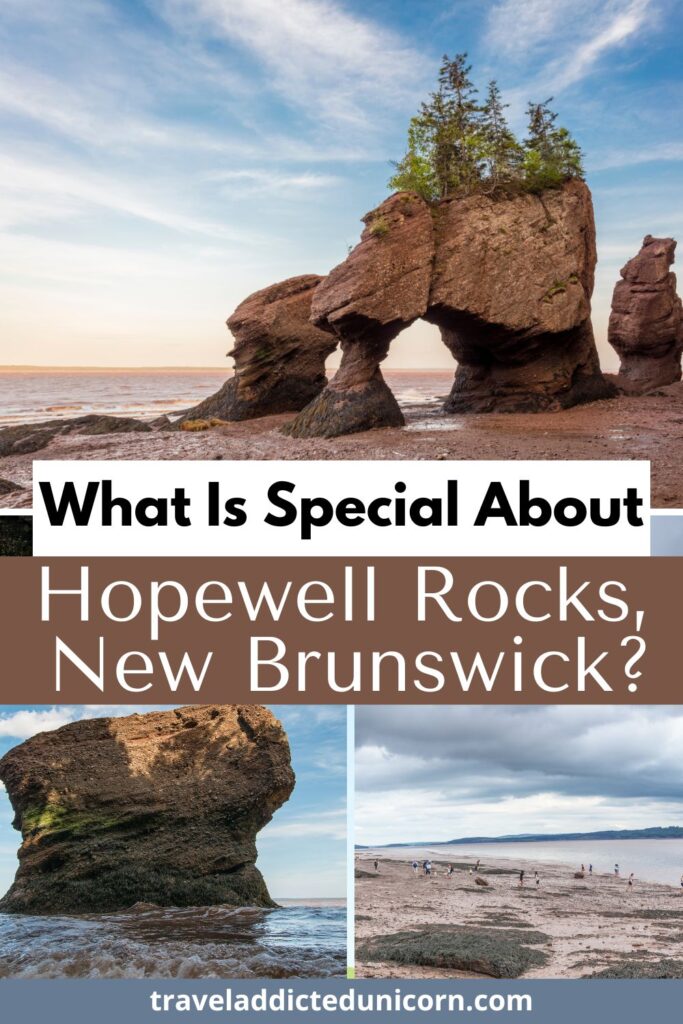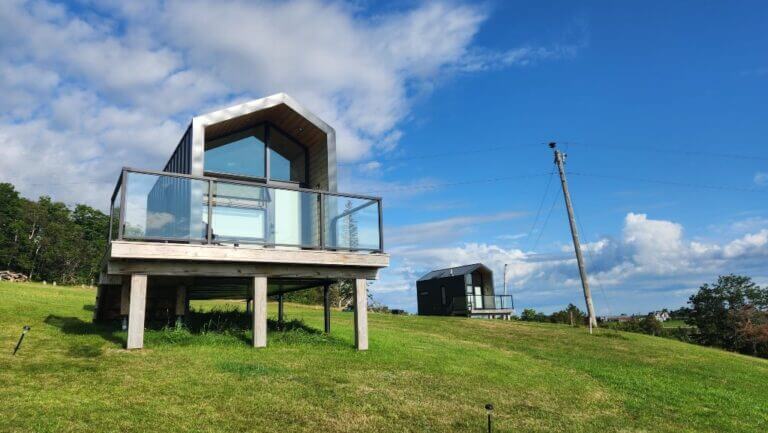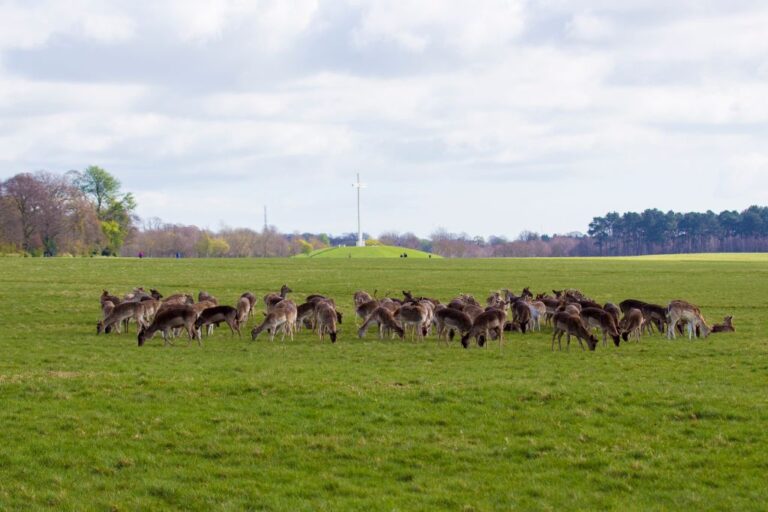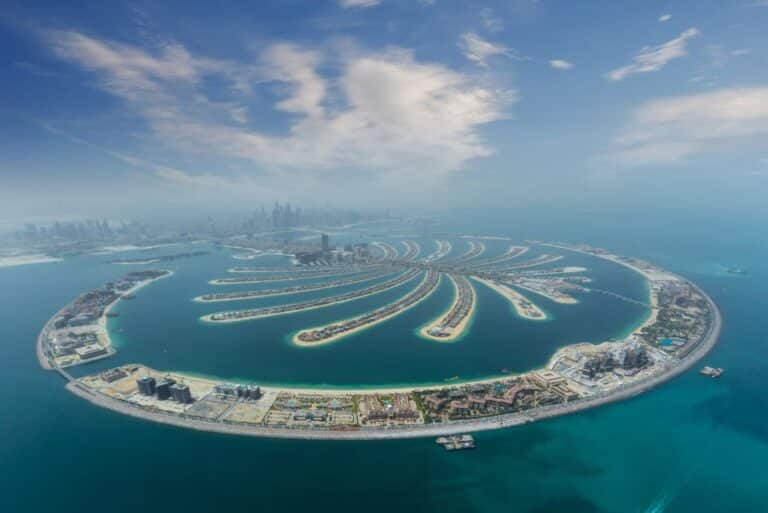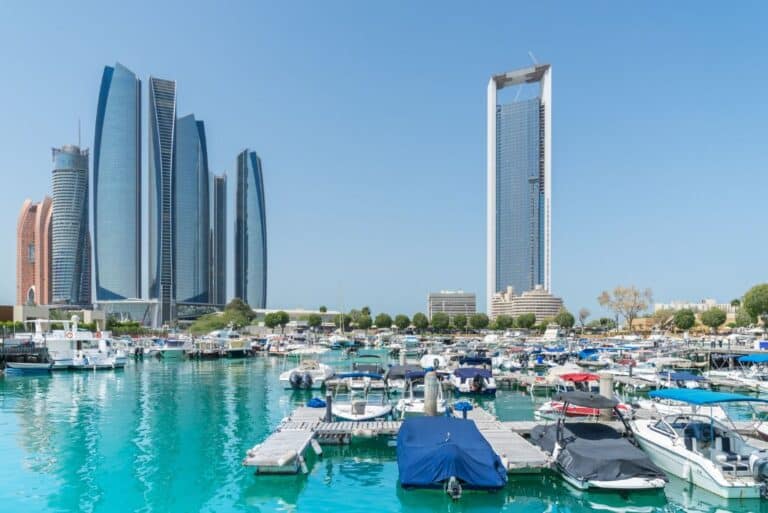What Is Special About Hopewell Rocks, New Brunswick?
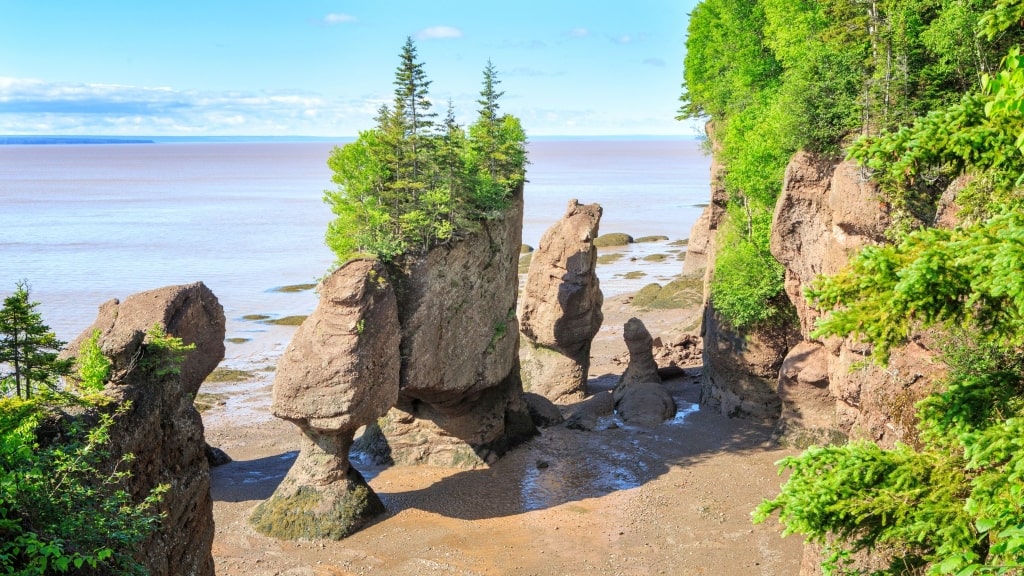

Planning To Visit New Brunswick, Canada And Wondering What Is Special About Hopewell Rocks Provincial Park? Keep Reading To Find Out!
Located along the stunning Bay of Fundy in New Brunswick, Hopewell Rocks Provincial Park is one of Canada’s most incredible natural wonders.
Famous for its towering rock formations, also known as the Flowerpot Rocks, this site offers a unique opportunity to witness the highest tides in the world.
At low tide, you can walk along the ocean floor and explore the intricate shapes of these massive rocks, while high tide transforms the area into a beautiful seascape.
Also, the park features an Interpretive Center with educational exhibits about the area’s geology, tides, and natural history, offering context for the formations and the ecosystem.
You will also find scenic walking trails and lookout points that provide stunning views of the Bay of Fundy and the rock formations.
We spent a full day at Hopewell Rocks Provincial Park, saw the lowest and highest tides and will share all of our experiences and tips with you in this comprehensive blog post.
What Is Special About Hopewell Rocks?
Hopewell Rocks is special because it offers a unique opportunity to experience the world’s highest tides, which rise and fall up to 14 meters (46 feet) in the Bay of Fundy.
Roughly 160 billion tonnes of water flow into the bay twice a day.
Erosion from the powerful tides has sculpted these distinctive, towering rock formations topped with trees and vegetation.
These formations have been shaped over thousands of years, creating a dramatic and surreal landscape.
Also, with the low tide, visitors can walk along the ocean floor, exploring the sea-carved rocks, caves, and arches.
A few hours later, at high tide, the area is completely submerged, allowing for kayaking around the formations.
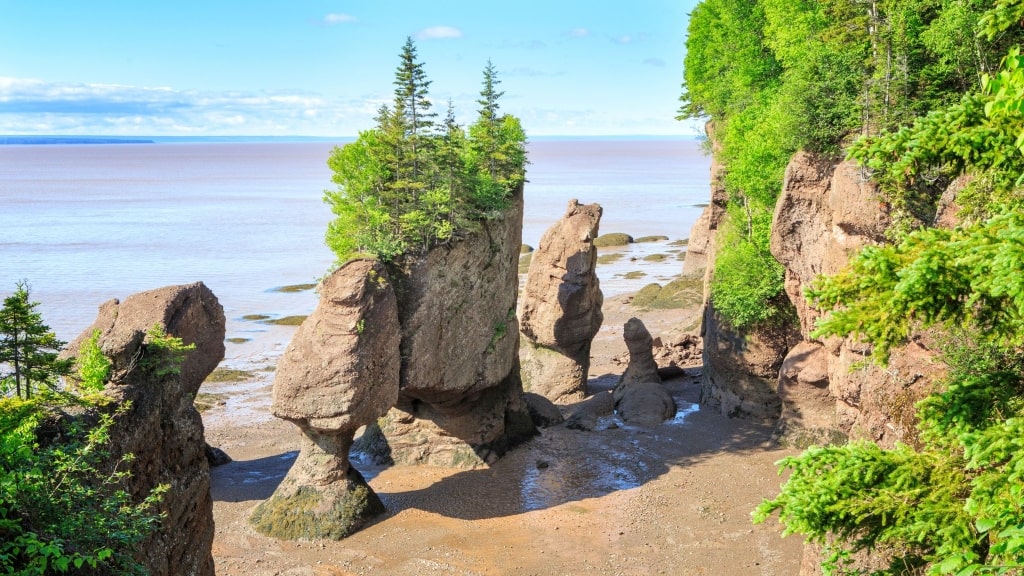
The tides change rapidly, and seeing the transformation between low and high tide is an awe-inspiring experience. Visitors can return within a six-hour window to see both extremes.
In addition, the area is surrounded by beautiful coastal landscapes, making it a prime spot for photographers and nature enthusiasts.
The tidal ecosystem supports a rich variety of wildlife, including shorebirds and various marine species, adding to its ecological significance.
These features make Hopewell Rocks a rare and fascinating destination for visitors seeking natural beauty and geological wonders.
👉 Grab your tickets here: Hopewell Rocks Admission
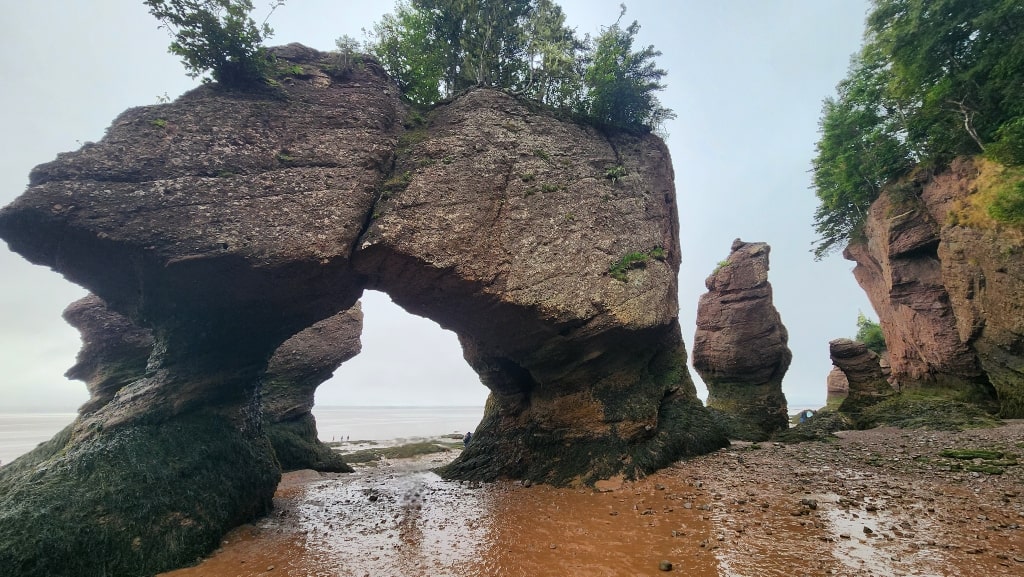
Where Is Hopewell Rocks Located?
Hopewell Rocks is located in Hopewell Cape, New Brunswick, Canada, along the shores of the Bay of Fundy.
The park is about a 45-minute drive from the city of Moncton. Making it a popular day trip destination for visitors to the area (that’s what we did).
The site is situated on the southeastern coast of New Brunswick. More specifically at 131 Discovery Rd, Hopewell Cape, NB E4H 4Z5.
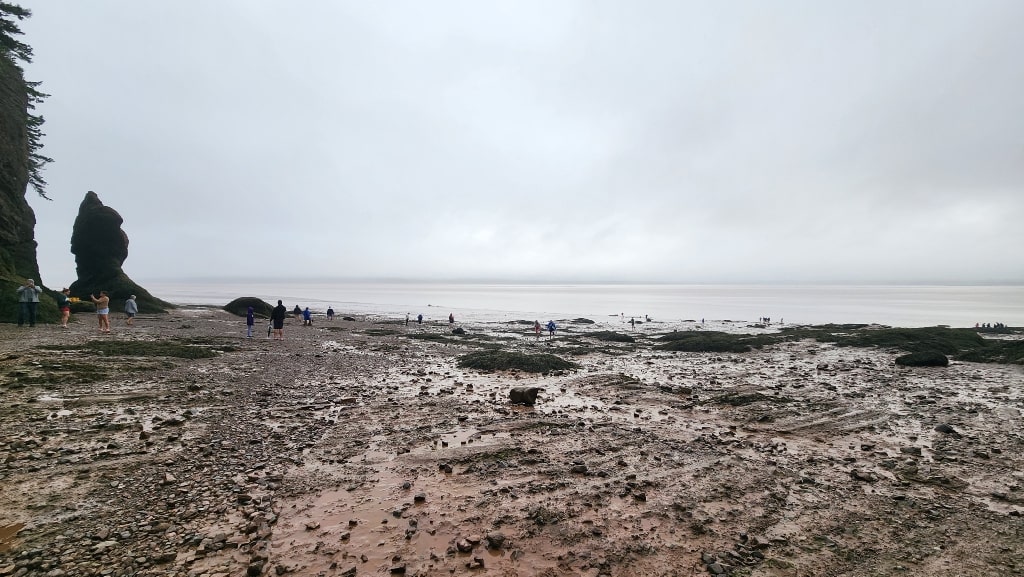
How To Drive To Hopewell Rocks?
From Moncton: Hopewell Rocks is about a 45-minute drive (approximately 40 km) southeast of Moncton. Take Route 114 south through Riverview and continue following signs for Hopewell Rocks Provincial Park.
From Saint John: It’s a 2-hour drive (around 170 km). You can take Route 1 east towards Moncton, then merge onto Route 114 to Hopewell Cape.
From Fredericton: The drive takes around 2.5 hours (about 200 km). Follow Route 2 (Trans-Canada Highway) towards Moncton, then take Route 114 as you head towards Hopewell Rocks.
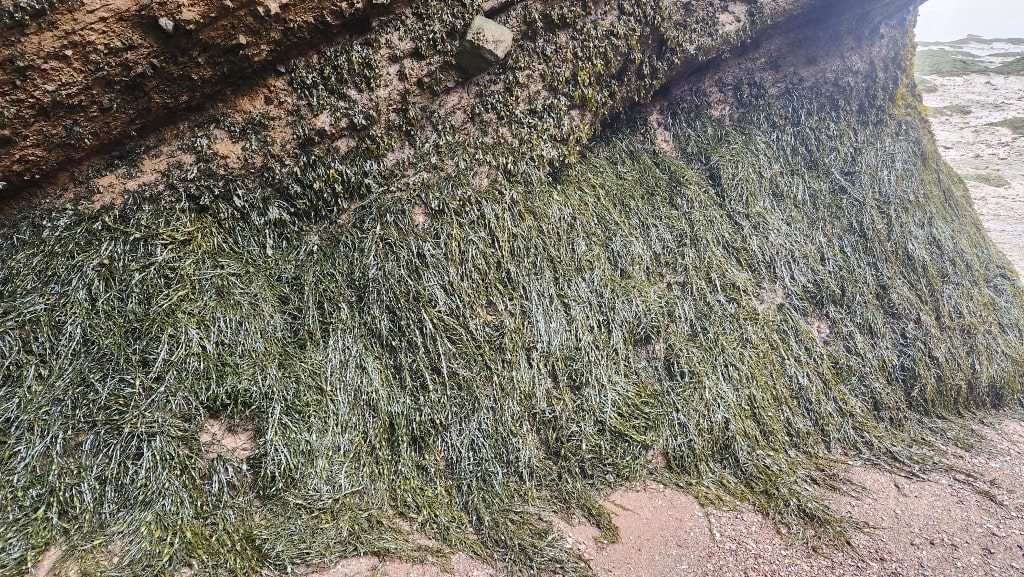
Is There Parking At Hopewell Rocks?
Yes, parking is available at Hopewell Rocks.
The park offers a large parking lot near the entrance, where visitors can park their vehicles for free.
Also, parking lot B has two Electric Charging Stations (Type 2). You will be charged a rate of $1.50 CAD for the first hour and $0.75 for every consecutive hour.
From the parking lot, you can either walk or take a shuttle (paid) down to Staircase Cove (the main viewing area) where you can access the ocean floor and the Flowerpot Rocks.
The shuttle is available seasonally and is especially useful for those who may prefer not to walk the full distance.
You will find the shuttle beside the Interpretive Centre, there is a small hut that is the shuttle stop. It is more like a golf cart than a bus.
Referencing this Hopewell Rocks Provincial Park map while you read this blog post will be helpful.
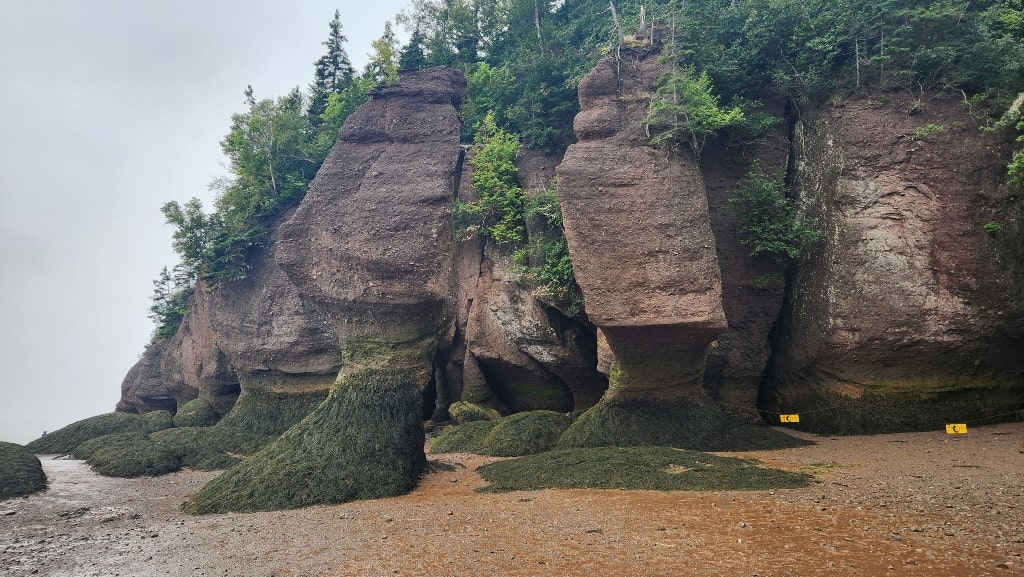
What Is The Best Time To See Hopewell Rocks?
The best time to visit Hopewell Rocks is during both low tide and high tide. So you can experience the full transformation of the landscape caused by the Bay of Fundy’s extreme tides. Here’s how to plan your visit:
Ideal Plan:
- Arrive 2-3 hours before low tide: This gives you time to explore the beach at low tide and then stay to watch the tide rise.
- Check the Tide Schedule: The tides at Hopewell Rocks change daily, so it’s important to check the tide schedule on the park’s website before your visit. The park is open to visitors all day, but visiting at the right time ensures you see the full tidal range.
How Much Does It Cost To See The Hopewell Rocks?
As of 2025, the entrance fees are:
- Adults (19 and older): $ 15.85 (plus HST*) CAD
- Seniors (60 and older): $ 13.59 (plus HST) CAD
- Youth (5 to 18 years): $ 9.06 (plus HST) CAD
- Students (19 and older, with ID): $ 13.59 (plus HST) CAD
- Children (under 5): Free
- A family pass (for two adults and two youths): $ 34.45 (plus HST) CAD
- Shuttle Service (Per Ride): $ 1.74 (plus HST) CAD – you can walk to the area where you can access the ocean floor on your own. The shuttle is an option for whoever doesn’t wish to walk. I would say it will take you about 15-20 mins to walk from the parking lot to the staircase that leads to the ocean floor. The shuttle would take you about 5 mins.
*HST is a harmonized sales tax which in New Brunswick is 15%
–Admission is valid for two consecutive days, which allows you to experience both low and high tides
–You can present a paper or digital copy of the purchase confirmation
-Also, there is a single transaction fee of $3.00 which will be added to the entire purchase (on the official website)
– During the off-season (October through mid-May), the park may be open but with no entrance fee or limited services, depending on the weather.
👉 Grab your tickets here: Hopewell Rocks Admission
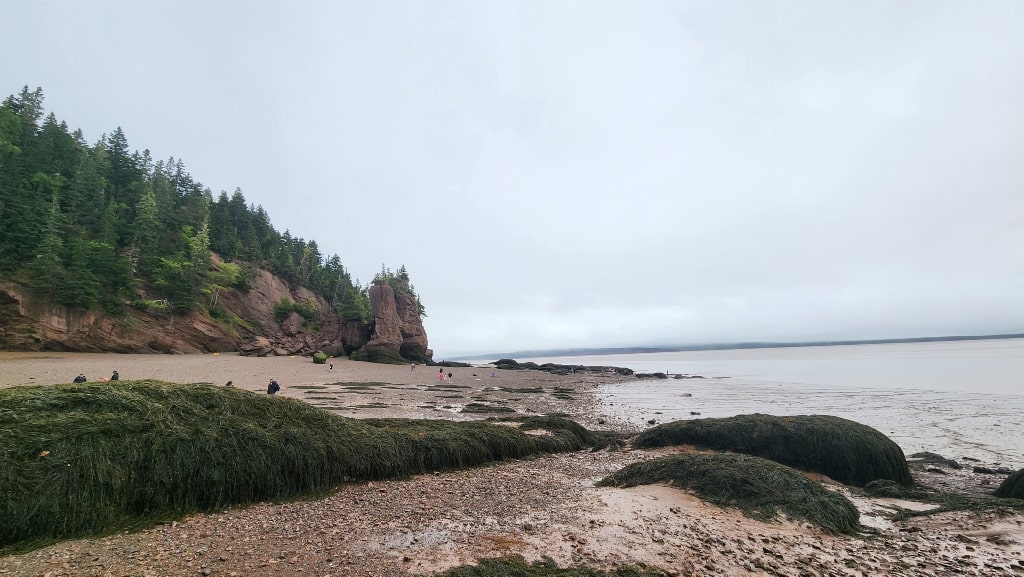
What Are The Hours Of Operation?
The hours of operation at Hopewell Rocks vary depending on the season.
May 16 – June 21 : 9:00 AM – 5:00 PM
June 22 – September 1: 8:00 AM – 8:00 PM
September 2 – October 1: 8:00 AM – 6:00 PM
October 2 – October 26: 9:00 AM – 5:00 PM
Also, keep in mind that Hopewell Rocks is a self-guided park. However, staff are available around the grounds to assist with any questions you may have.
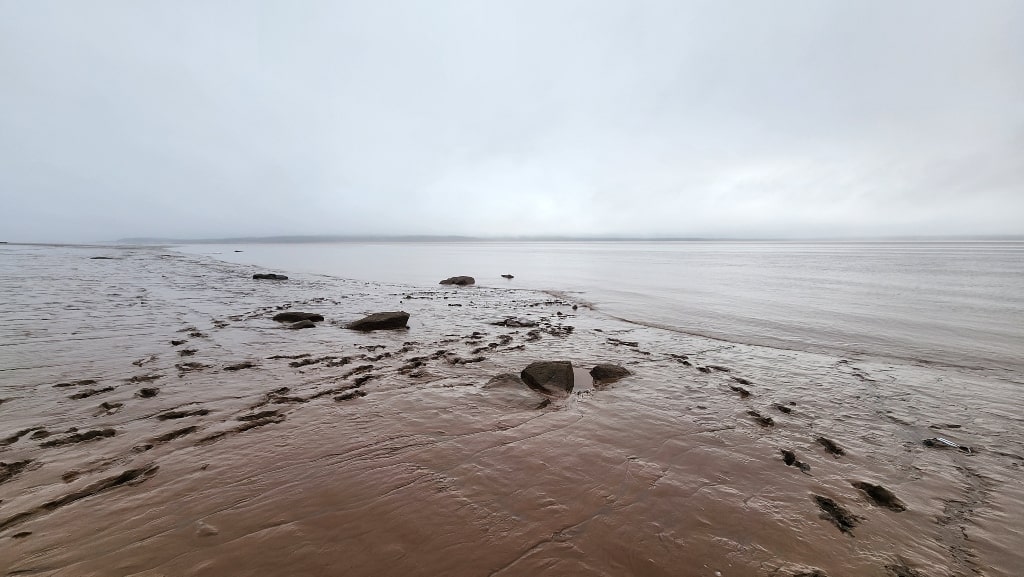
How Long Do You Need To Visit Hopewell Rocks?
To fully experience Hopewell Rocks, it’s recommended to allocate at least 3 to 4 hours. This allows you enough time to explore the ocean floor during low tide, walk among the “flowerpot” rock formations, and later observe the dramatic transformation as the tide rises.
Here’s how you might spend your time:
- 1 to 2 hours to explore the ocean floor, take photos, and walk along the beach during low tide.
- 1 hour to visit the Interpretive Centre, learn about the tides and geology, and enjoy a meal at the High Tide Café.
- Another 1 to 2 hours if you wish to return for high tide or take part in activities like kayaking.
If you’re short on time, a 2-hour visit is still enough to see the highlights at one tide cycle.
However, seeing both high and low tide on the same day gives you a complete experience of Hopewell Rocks. I highly recommend seeing both if you can.
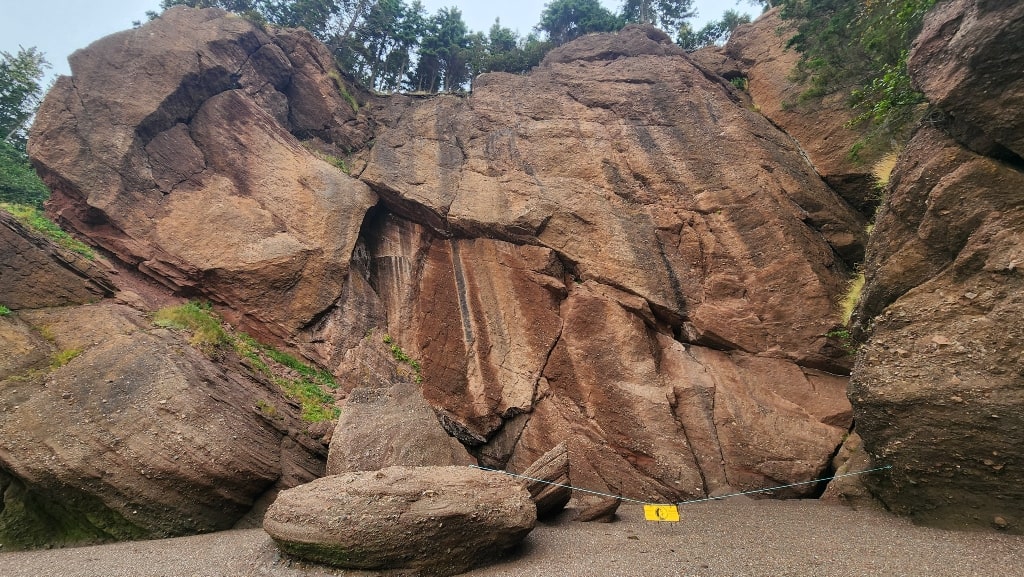
How Do I Know When To Visit During The Day?
Check the tide schedule in advance so you can explore the ocean floor at low tide and see the rock formations submerged at high tide.
The time period between low and high tide is 6 hrs and 13 mins.
This means that you can walk on the ocean floor from 3 hrs before low tide until 3 hrs after.
Keep in mind that the tide times change every day so make sure you check the time for the day you are visiting specifically.
There is a big sign where the stairs start at Staircase Cove that has the exact times for that day.
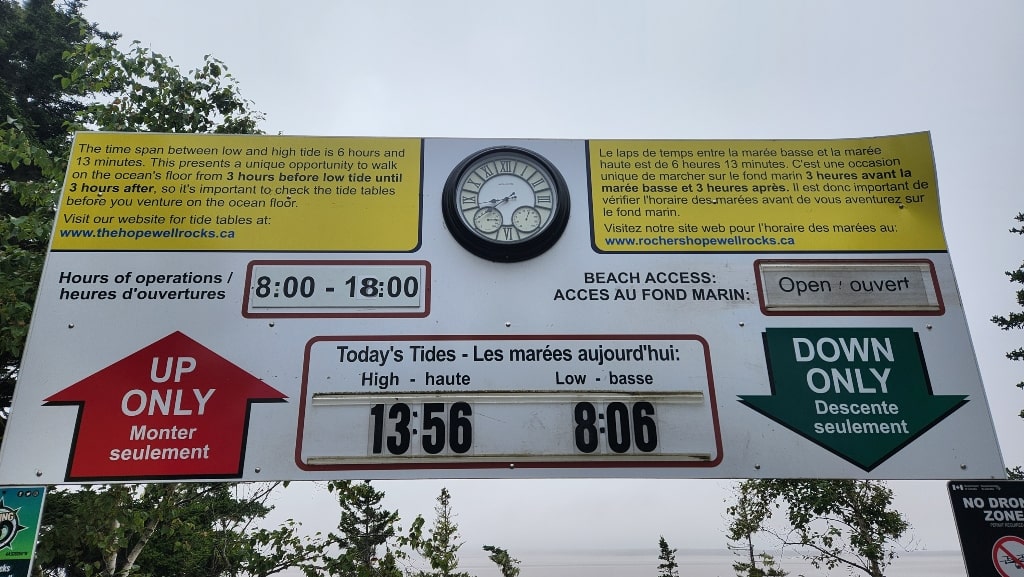
Know Before You Go
Before visiting Hopewell Rocks, here are a few key things to know to make the most of your experience:
Wear shoes and clothes that you don’t mind getting dirty – No matter how hard you try, you will get dirty so wear something you don’t care about. There is an area by the top of the stairs where you can wash the mud from your shoes but keep in mind the water is freezing cold.
Weather Conditions – The weather can change quickly near the coast, so it’s a good idea to dress in layers and bring a rain jacket just in case. Check the forecast before heading out.
Best Time to Visit – The best time to visit is between mid-June and mid-September when the weather is warmest, and the park’s facilities, including the café, are fully operational.
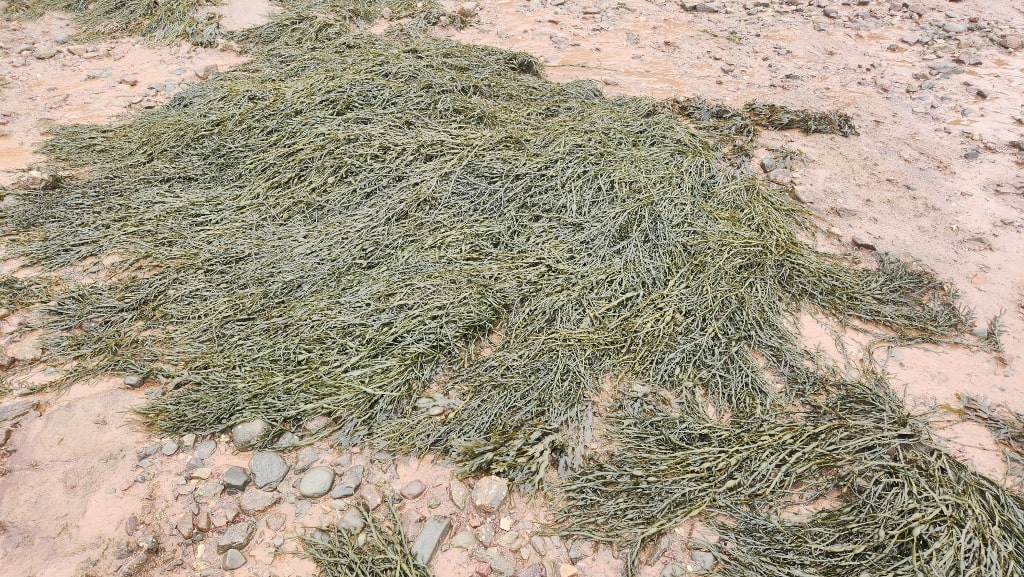
No campgrounds/accommodations – There are no campgrounds, RVing or any other accommodations at Hopewell Rocks Provincial Park. Therefore, you need to find accommodations outside of the park.
Safety at Low Tide – The tide changes quickly, so be mindful of the tide times. Park staff and signage will indicate when you need to leave the ocean floor to avoid being caught by the rising tide.
Bring Snacks and Water – While the High Tide Café is on-site, it’s good to bring your own snacks and water, especially if you plan to spend several hours exploring the trails and shoreline.
Park Trails And Viewpoints – There are several walking trails and viewpoints around the park that offer scenic views of the rocks and the Bay of Fundy. The trails are easy to walk on, but still wear comfortable shoes. Check out the Diamond Rock Viewpoint.
Flying drones is not allowed anywhere in the park.
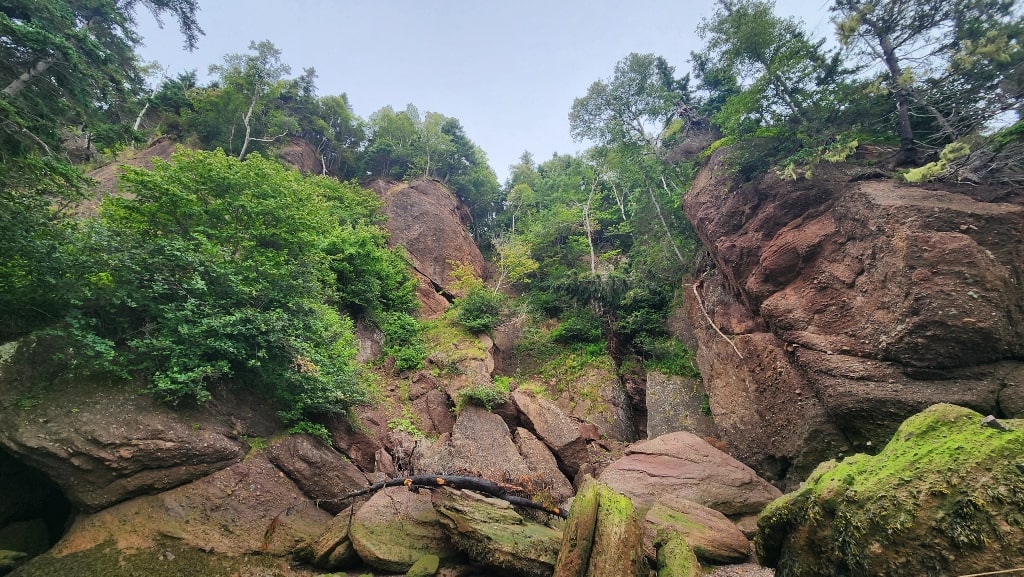
What Else Is There At Hopewell Rocks?
Let’s see what else is there in Hopewell Rocks Provincial Park besides watching the tides.
Interpretive Center
The Interpretive Centre at Hopewell Rocks serves as an educational hub where visitors can learn about the area’s unique geological and ecological significance.
It provides a deeper understanding of the Bay of Fundy’s massive tidal changes, the formation of the famous “flowerpot” rock structures, and the wildlife that inhabits the region.
The center features exhibits, multimedia displays, and informative panels explaining the history, geology, and biodiversity of Hopewell Rocks.
You can learn about how the tides have shaped the landscape over millions of years and the ongoing effects of erosion.
Also, there are interactive displays and video presentations that explain the tides and how best to explore the site safely.
It’s a great starting point before heading out to explore the trails and rock formations. Alternatively, you can visit while waiting between tide cycles.
Inside the Interpretive Centre, there are flushable washrooms as well as a large gift shop. There are outhouses around the trails too.
Also, around the center, there are picnic areas and playgrounds for children.
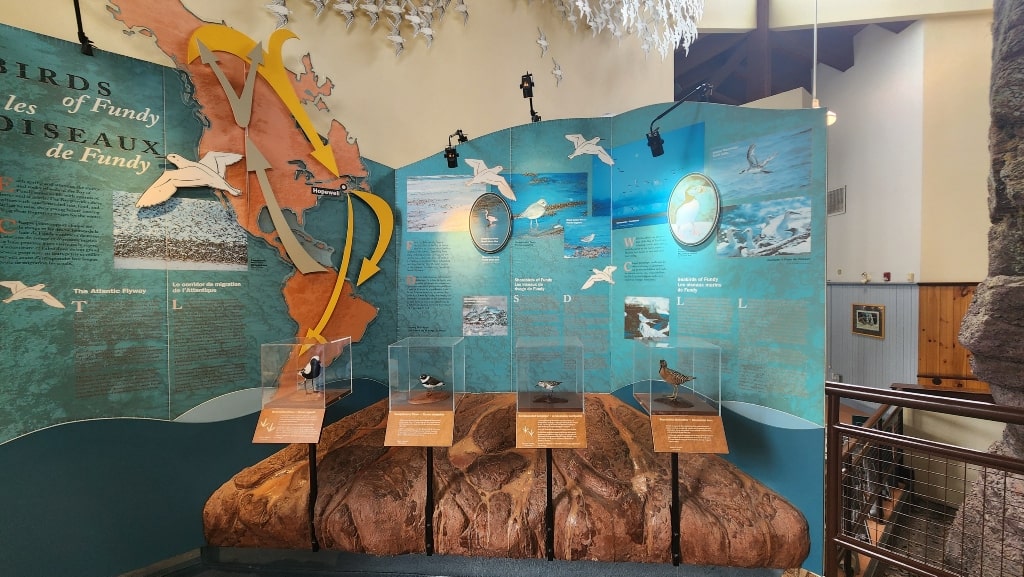
Restaurant (High Tide Café)
The restaurant at Hopewell Rocks is called the High Tide Café.
Located near the Interpretive Centre, the café offers casual dining with a variety of options such as sandwiches, soups, salads, and snacks.
It’s a convenient place to grab a meal or refreshments while visiting the park. Also, the café provides outdoor seating, allowing visitors to enjoy the beautiful surroundings.
If you’re planning to spend a full day exploring, the café is a great spot to refuel without leaving the site.
I had the Tidal Bay Burger with the Seafood Chowder as a side as well as a Caramel Iced Coffee to go.
My partner had a Cheeseburger with a Poutine. We both loved the food but it did take a while to come.
All of the patties are from the Country Butcher in Sussex, New Brunswick and all of the buns are made fresh from Oliver’s German Bakery in Hillsborough, New Brunswick.
Therefore, the burgers are fresh and tasty.

Staircase Cove (Main Spot For Ocean Floor Access)
Staircase Cove is the main place to go to and is specifically designed to give visitors access to the ocean floor during low tide.
It’s a section of the park where you can descend a series of steps (101 stairs to be exact) to reach the beach area below.
Which allows for closer exploration of the rock formations and the surrounding tidal landscape.
From Staircase Cove, you can get up close to the “flowerpot” rocks and experience the unique tidal features of the Bay of Fundy.
There are several vantage points for taking photos. Also, remember that the stairs are divided into sections for ascending and descending.
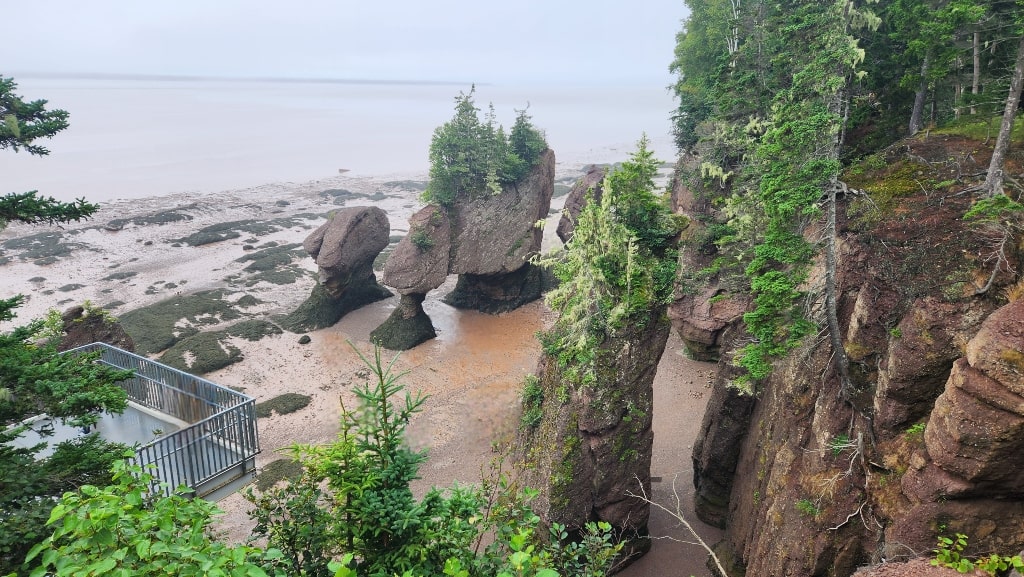
The walk from the Interpretive Centre is 0.8 km/0.5 miles one-way. The path is wide and well-maintained, but it is through a forest so there can be some uneven sections.
Once you get to the ocean floor, you will have the option to walk to the right or the left. The right side is longer but both are worth seeing.
If you go right, you will see the following flowerpots: Lovers Arch, Bear Rock, Apple Rock, Castle Cove, Elephant Rock, Sea Cave, Big Cove and Diamond Rock.
Past Diamon Rock, the path is blocked with a pile of large stones and you cannot go further.
Going left from the staircase, you will see the E.T. rock as well as the Mother-In-Law rock.
The path ends at North Beach, which also has an access ramp.
👉 Grab your tickets here: Hopewell Rocks Admission
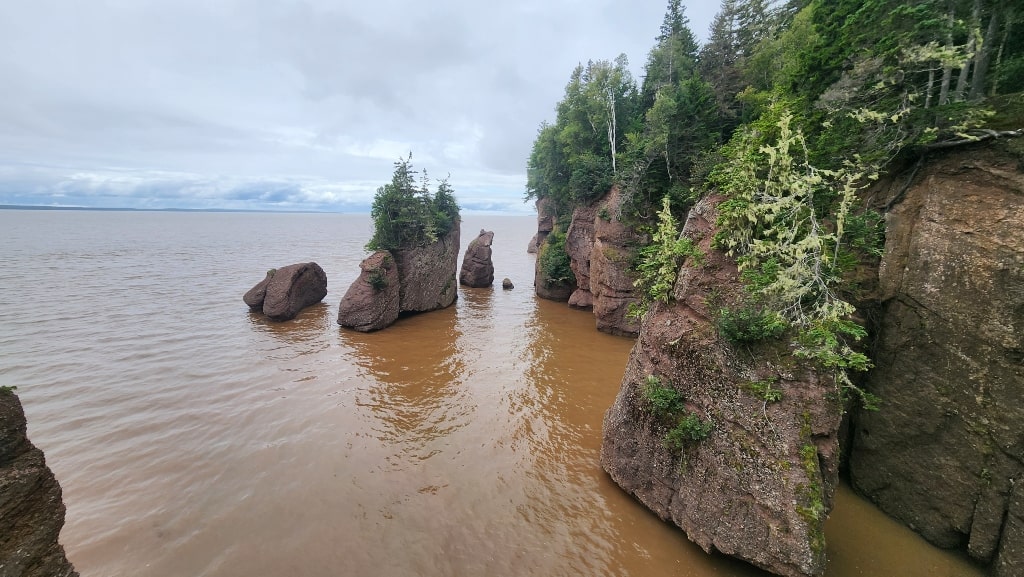
North Beach (Ocean Floor Access)
The North Beach at Hopewell Rocks is another area where visitors can explore the ocean floor during low tide.
Located on the northern side of the park, it provides an ideal spot for visitors to walk along the shore and enjoy a quieter part of the park compared to other sections.
Also, this is where the accessibility ramp is located in case you don’t feel like climbing 101 stairs. This is where you will go to do the guided kayaking tour.
There is a small parking lot here as well but keep in mind it is only for people doing the guided kayaking tour or who need accessible parking.
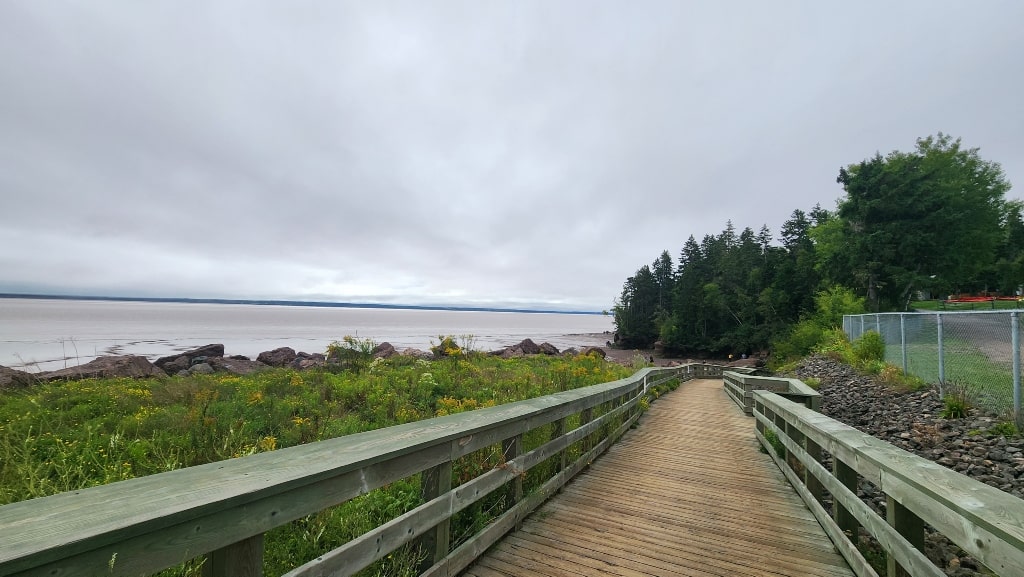
Demoiselle Beach (Ocean Floor Access)
Demoiselle Beach is a lesser-known, picturesque spot located within Hopewell Rocks Provincial Park.
It’s a serene stretch of sandy beach that becomes accessible at low tide. Offering visitors a peaceful area to explore beyond the more crowded parts of the park.
Visitors can walk along the shoreline, explore tide pools, and enjoy the natural beauty of the area in a quieter, more secluded setting compared to other popular spots like Staircase Cove.
However, keep in mind that it is a bit of a walk to get to it – 0.7 km/0.43 miles one-way. The path starts right behind the Interpretive Centre and goes south.
This path gently descends to sea level and offers views of Shepody Mountain, Mary’s Point and Grindstone Island.
*It doesn’t matter which of the three access points you choose to visit. Because the shoreline will be equally exposed during low tide.
Kayaking
Kayaking in Hopewell Rocks during high tide is one of the most popular activities at the site.
Also, kayaking allows you to explore the “flowerpot” rock formations from a unique perspective as the water rises around them.
Baymount Outdoor Adventures is the official tour operator and offers guided kayaking tours.
During the kayaking tour, you can paddle around the towering rocks, arches, and cliffs, giving you a closer look at the Bay of Fundy’s incredible tides.
There are three types of tours: the Signature High Tide Tour (1.5 to 2 hours, 4 km), the Mid-Tide Tour (1.5, 3 to 4 km) and After Dark (weather dependent).
According to their website, you do not need to be an experienced kayaker to participate. Actually, most people kayaking at Hopewell have no previous experience.
However, you will receive instructions and basic training on how to properly use the kayak.
The experience is not suitable for children under 10 years of age.
Kayaking at Hopewell provides a peaceful and scenic adventure that you cannot experience elsewhere.
Keep in mind that you cannot bring and use your own kayak, it has to be a guided tour.
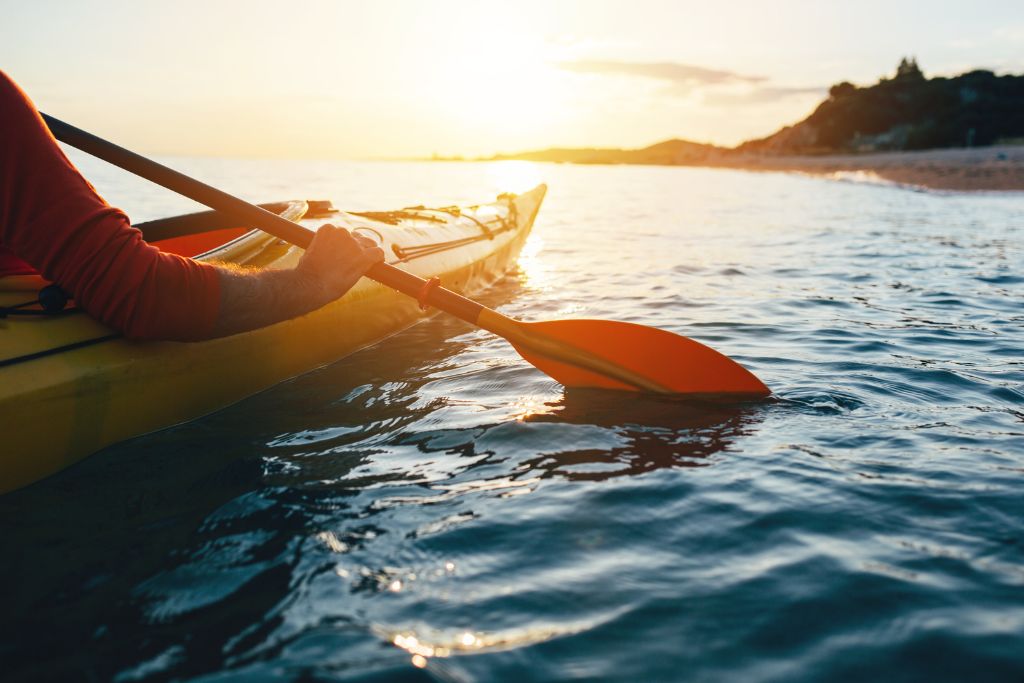
What To Bring With You When Visiting Hopewell Rocks?
Here’s a list of what to bring when visiting Hopewell Rocks:
- Sturdy Footwear – Waterproof hiking shoes or boots with good traction.
- Clothing Layers – Light jacket and layers for varying weather conditions.
- Sun Protection – Sunscreen, hat, and sunglasses.
- Water Bottle – Refillable for staying hydrated.
- Snacks or a Picnic – Pack food for extended stays.
- Camera or Smartphone – To capture the rock formations and tides.
- Tide Schedule – To plan your visit around low and high tides.
- Binoculars – For wildlife viewing, especially during migration seasons.
- Bag for Muddy Shoes – To store dirty shoes after exploring.
- Backpack – To carry your belongings, snacks, and extra clothes.
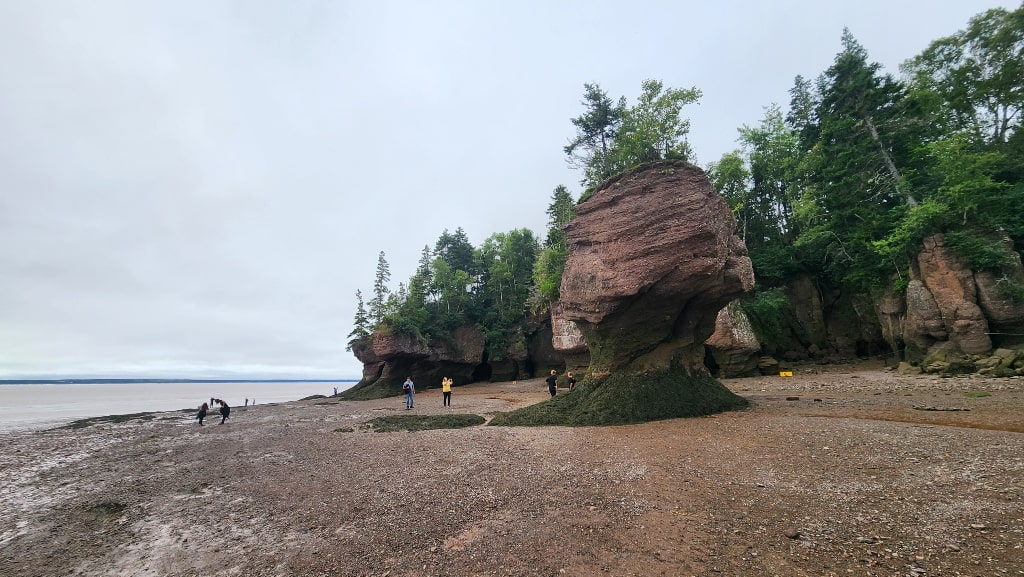
FAQs
Let’s take a look at some of the most frequently asked questions when it comes to visiting Hopewell Rocks Provincial Park.
Is it better to see high tide or low tide?
Both high and low tide at Hopewell Rocks offer unique and stunning experiences, so it really depends on what you’re most interested in seeing:
Low Tide: This is when you can walk on the ocean floor and explore the iconic “flowerpot” rock formations up close. You can wander through arches, caves, and around the base of these massive rock structures, which are uncovered when the water recedes. If you do not have time to see both, then you must see the low tide.
High Tide: During high tide, the water rises dramatically and covers much of the rock formations, which creates a completely different perspective. The contrast between the high and low tide levels is one of the most spectacular features of the site. During the high tide, you cannot access the ocean floor. However, you can check out the tide change from all the viewpoints around the park.
To fully appreciate Hopewell Rocks, you should see both tides on the same day. You can arrive at low tide to explore on foot and return later to see the dramatic rise of the water at high tide.
Alternatively, because the admission ticket is valid for two consecutive days, you can come back the next day to see the tide you missed the first day.
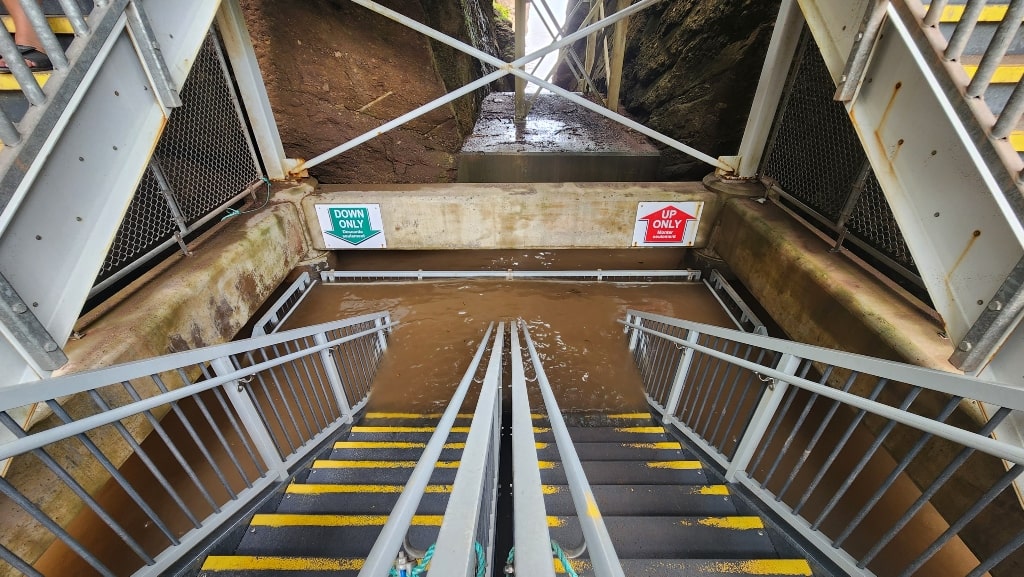
why is the water at Hopewell Rocks so brown?
The water at Hopewell Rocks appears brown due to the high levels of silt and sediment carried by the Bay of Fundy’s powerful tides.
The extreme tidal fluctuations constantly stir up mud, clay, and organic matter from the ocean floor and surrounding areas, suspending it in the water.
This continuous movement of sediment gives the water its characteristic muddy or brownish color.
Especially during low tide when the ocean floor is exposed and more sediment is disturbed.
The sediment-rich water is a natural feature of the Bay of Fundy, reflecting the area’s unique geology and tidal forces.
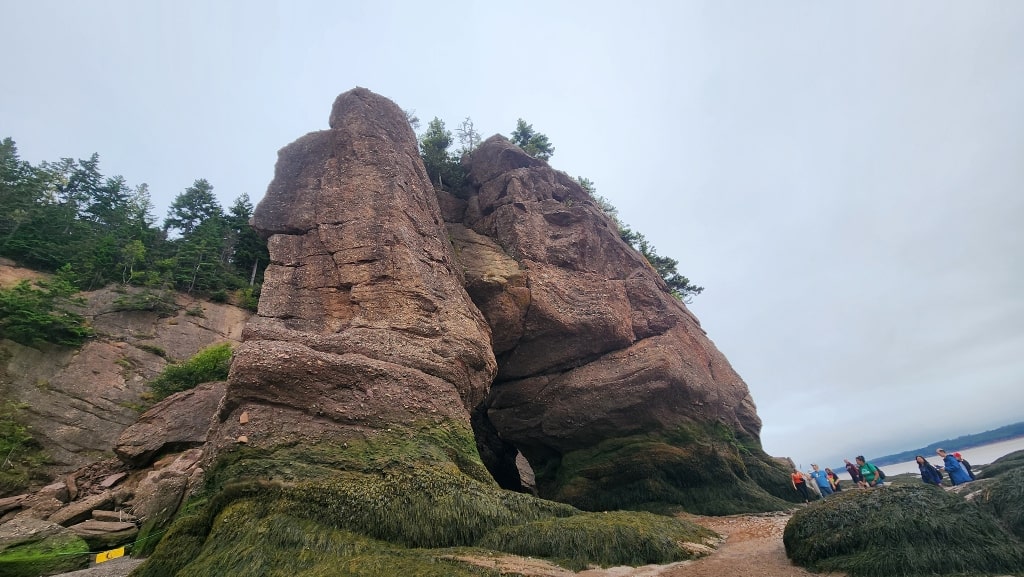
Are dogs allowed in Hopewell Rocks?
Yes, dogs are allowed at Hopewell Rocks as long as they are on a leash.
The park is dog-friendly, but owners are expected to clean up after their pets and keep them under control.
However, it’s important to note that some areas, such as the beach or muddy spots, may be more difficult to navigate with dogs due to the mud and terrain.
We had our dog with us, but he is a big boy and didn’t have any issues but smaller doggies may find it more difficult.
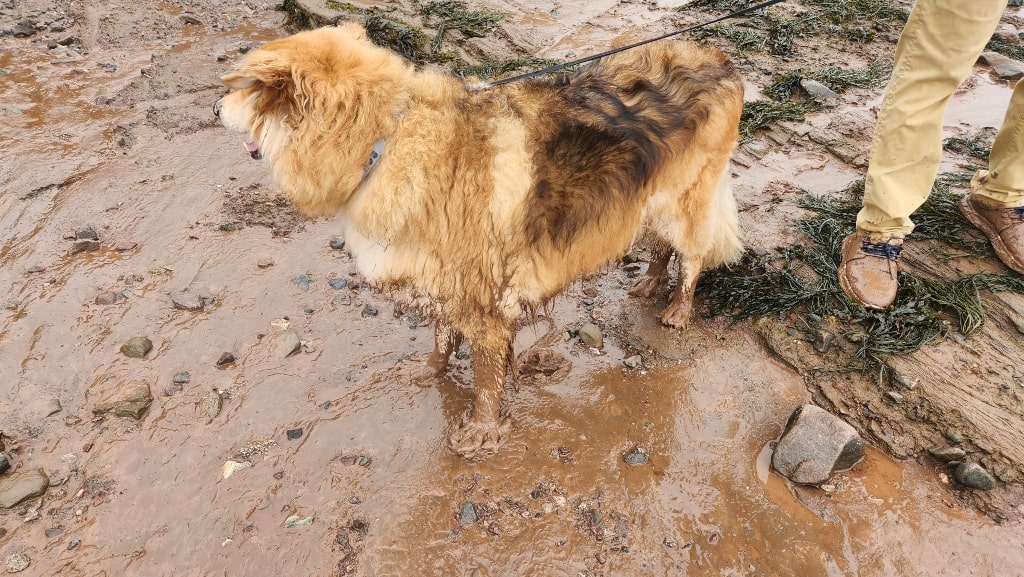
Can I swim in Hopewell Rocks?
No, swimming is not allowed at Hopewell Rocks.
The area is known for its extremely high tides, with water levels rising quickly and dramatically, which can make swimming dangerous.
Also, the currents and changing tides create hazardous conditions, and it’s not recommended to enter the water for swimming.
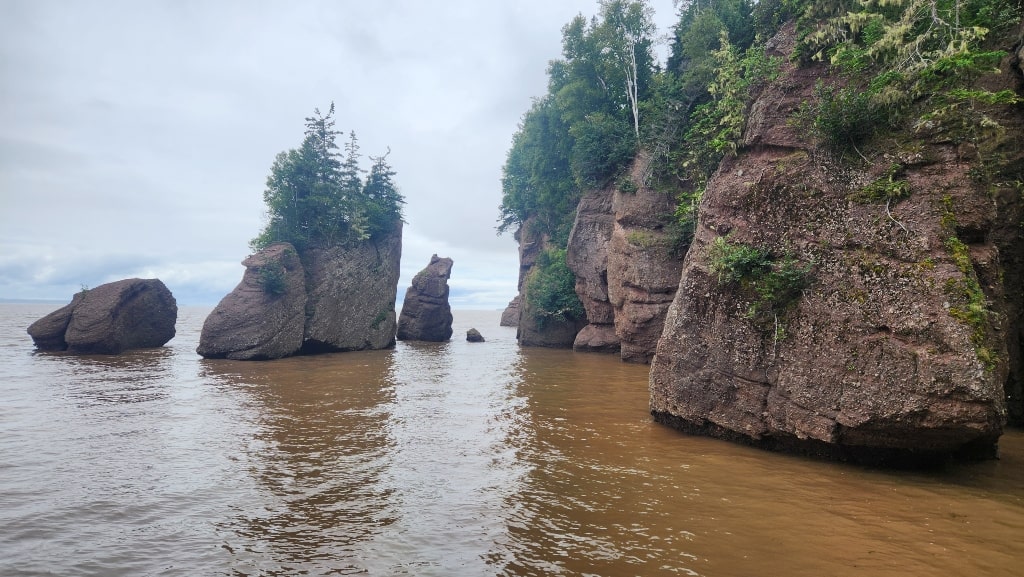
What shoes should I wear?
When visiting Hopewell Rocks, it’s important to wear the right footwear, especially if you’re exploring during low tide. Here’s what to consider:
Sturdy Hiking Shoes or Sneakers: The terrain can be uneven, with rocks and roots along the trails, so supportive, comfortable shoes are ideal. Hiking shoes with good traction will help you navigate safely.
Waterproof or Mud-Resistant Footwear: The ocean floor at low tide is often muddy and slippery, so waterproof shoes or boots are highly recommended. Avoid shoes that are difficult to clean, as they might get quite muddy. I wore rain boots and got really stuck in the mud that was close to where the water was. I recommend not going that far and sticking to the main trail (drier) otherwise you will get super muddy.
Avoid Sandals or Open-Toed Shoes: These don’t provide enough protection or traction for walking on rocks, in mud, or around slippery areas. Having said that, I saw a lot of people wearing flip-flops and crocks and some took them off in the mud to avoid getting stuck like me. Also, a lot of people were barefoot after the mud soaked their shoes.
If you’re planning to visit both high and low tide, it’s a good idea to bring extra footwear in case your shoes get wet or muddy during your visit.
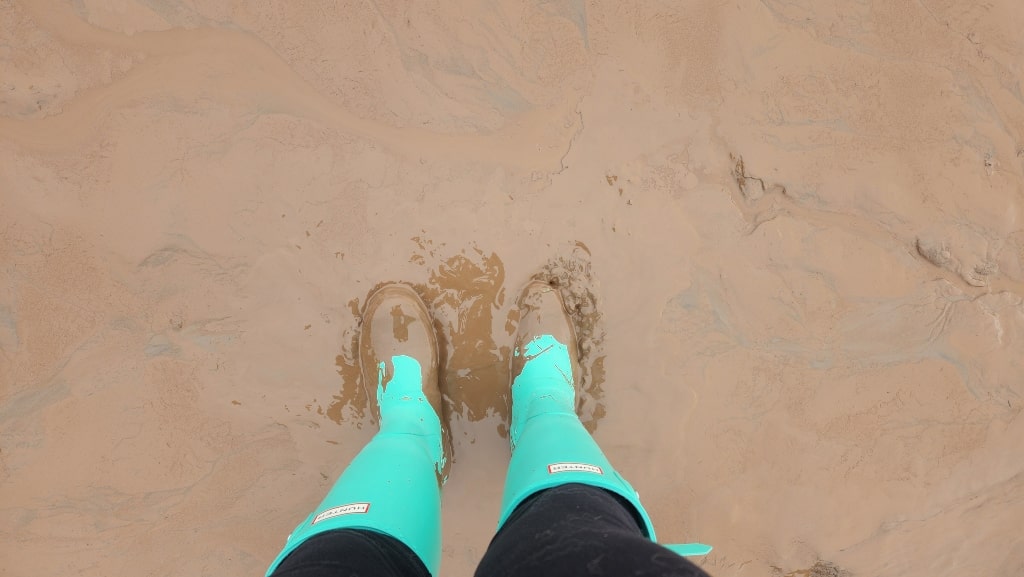
Can you go to Hopewell Rocks after hours?
No, visitors cannot enter Hopewell Rocks after hours.
The park operates on set hours, which vary depending on the season, and entry is restricted outside of these times for safety reasons.
The tide changes quickly and exploring the ocean floor without park staff and safety measures in place can be dangerous.
However, the area surrounding Hopewell Rocks offers scenic views from outside the park.
Therefore, you can still enjoy the coastline and the changing tides from a distance.
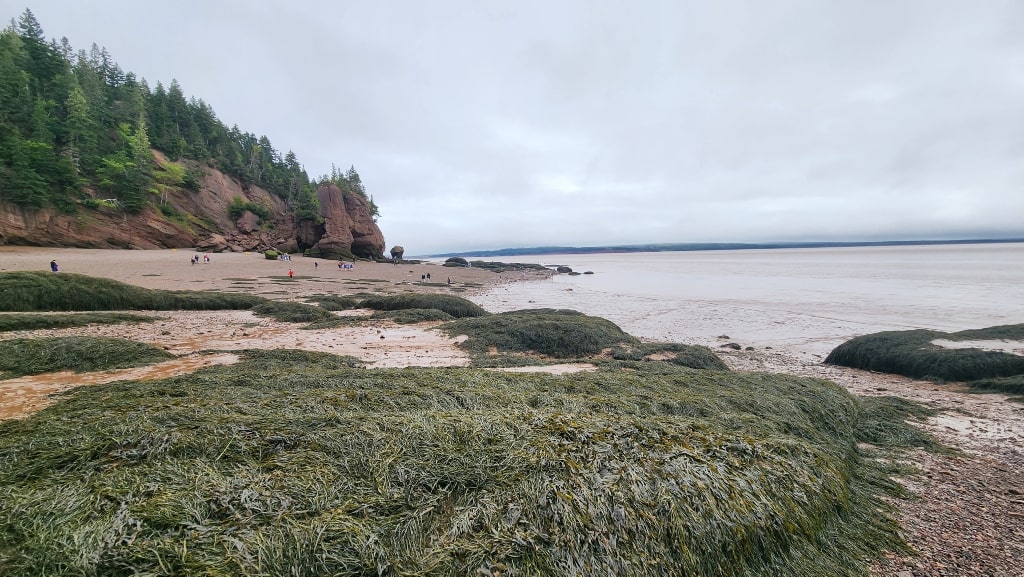
Why are the Bay of Fundy tides so high?
The Bay of Fundy experiences the highest tides in the world due to a combination of its unique geography and natural tidal forces.
The Bay has a distinctive funnel shape, narrowing and becoming shallower as it extends inland.
As the tide flows into this narrowing space, the water is forced higher and higher, amplifying the tidal range.
Also, the Bay of Fundy’s natural resonance plays a crucial role in its high tides. The bay’s length and depth are perfectly tuned with the timing of the Atlantic Ocean’s tidal cycle.
This means that as the water flows into the bay, it creates a resonating effect, like water sloshing in a bathtub, causing the tides to rise significantly.
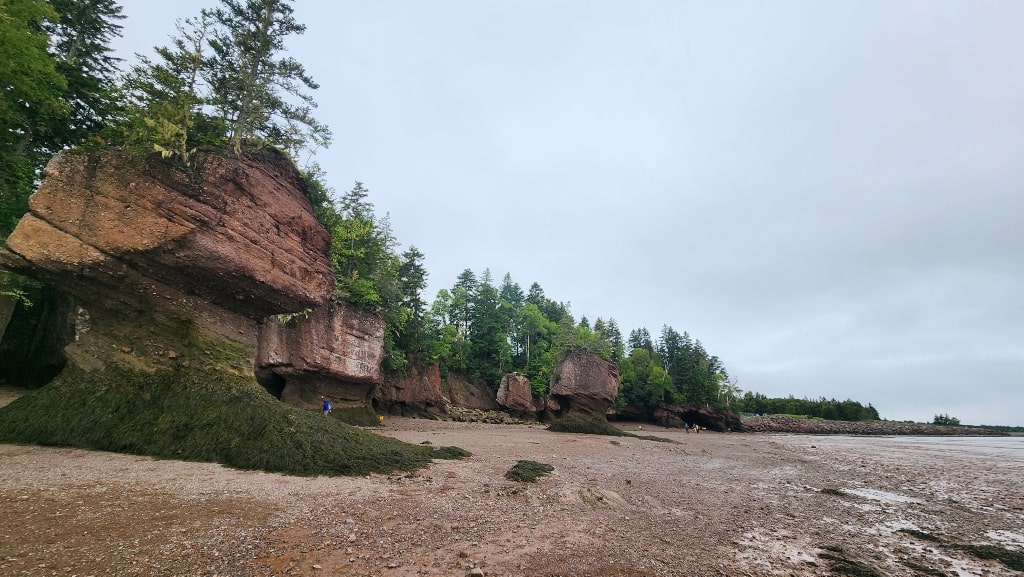
As the Atlantic Ocean’s tide comes in, it pushes a large volume of water into the bay.
Due to the bay’s unique topography and the resonance effect, this water continues to build up.
Resulting in a dramatic difference between high and low tides, sometimes up to 16 meters (52 feet).
The gravitational pull of the moon and the sun influences the tides in the Bay of Fundy.
However, the bay’s geography amplifies the effect, leading to more extreme tides compared to other coastal areas.
These combined factors make the Bay of Fundy’s tides a spectacular natural phenomenon.
Attracting visitors from around the world to witness the dramatic ebb and flow of water.
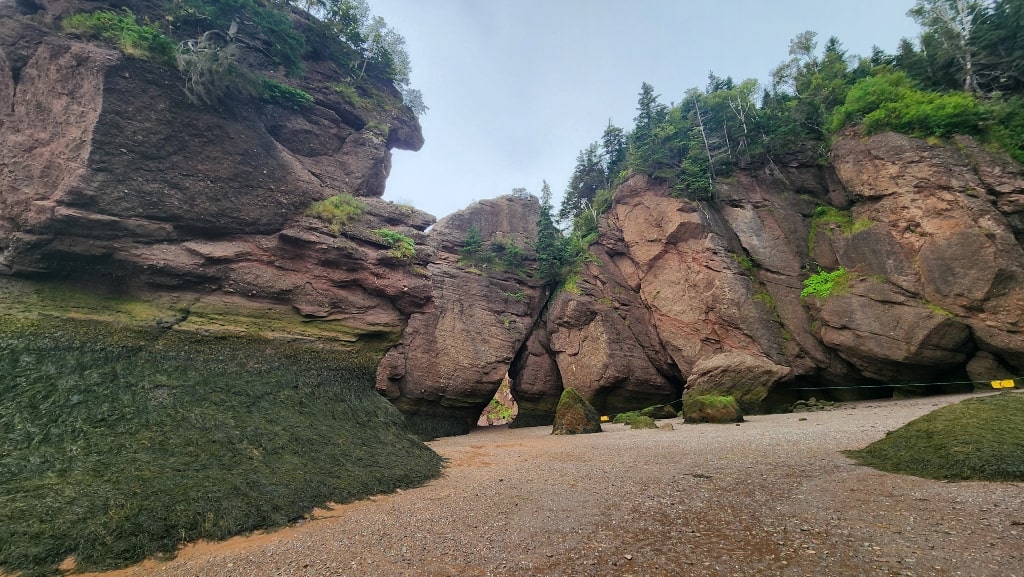
Is Hopewell Rocks Worth Visiting?
Yes, Hopewell Rocks is definitely worth visiting, particularly for its stunning natural beauty and the unique tidal experience it offers.
Hopewell Rocks provides a one-of-a-kind experience that you cannot find anywhere else. It is 100 percent worth checking out.
Its dramatic tides, combined with the iconic “flowerpot” create a unique and ever-changing landscape that is both awe-inspiring and serene.
Hopewell Rocks offers a truly unforgettable experience for anyone who appreciates nature’s wonders.
👉 Grab your tickets here: Hopewell Rocks Admission
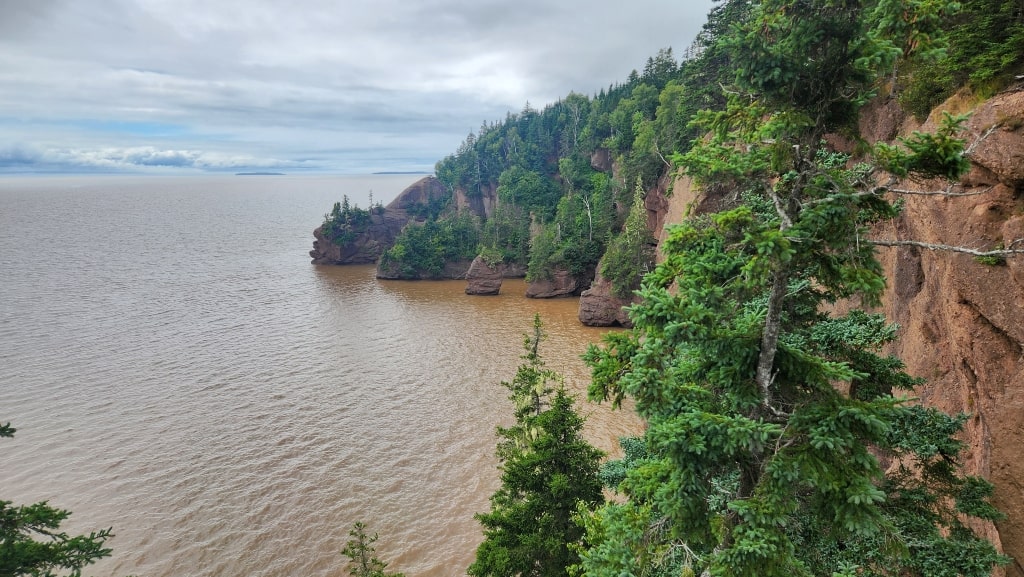
What Other Attractions Are Near Hopewell Rocks?
Here are a few more attractions near Hopewell Rocks that offer a variety of experiences.
The Cape Enrage Nature Preserve (30-minute drive) – In addition to the Cape Enrage Lighthouse, the area features scenic hiking trails with coastal views, a beach for fossil hunting, and outdoor adventure activities like zip-lining and rock climbing.
Fundy National Park (45-minute drive) – A stunning national park offering hiking trails, camping, and breathtaking views of the Bay of Fundy. The park features waterfalls, forested areas, and coastal cliffs.
Bouctouche Dunes and Irving Eco-Centre (1.5-hour drive) – The Bouctouche Dunes offer a peaceful beach with a boardwalk that stretches along the dunes, allowing visitors to explore the area while protecting the fragile ecosystem.
Joggins Fossil Cliffs (2-hour drive, via the Fundy coast) – A UNESCO World Heritage Site, the Joggins Fossil Cliffs provide an extraordinary opportunity to explore fossils from the Carboniferous period (over 300 million years ago).
St. Martins Sea Caves and Fundy Trail Parkway (2-hour drive) – The sea caves at St. Martins are carved by the powerful tides of the Bay of Fundy, and they can be explored during low tide. The nearby Fundy Trail Parkway offers stunning coastal views, hiking, and cycling opportunities.
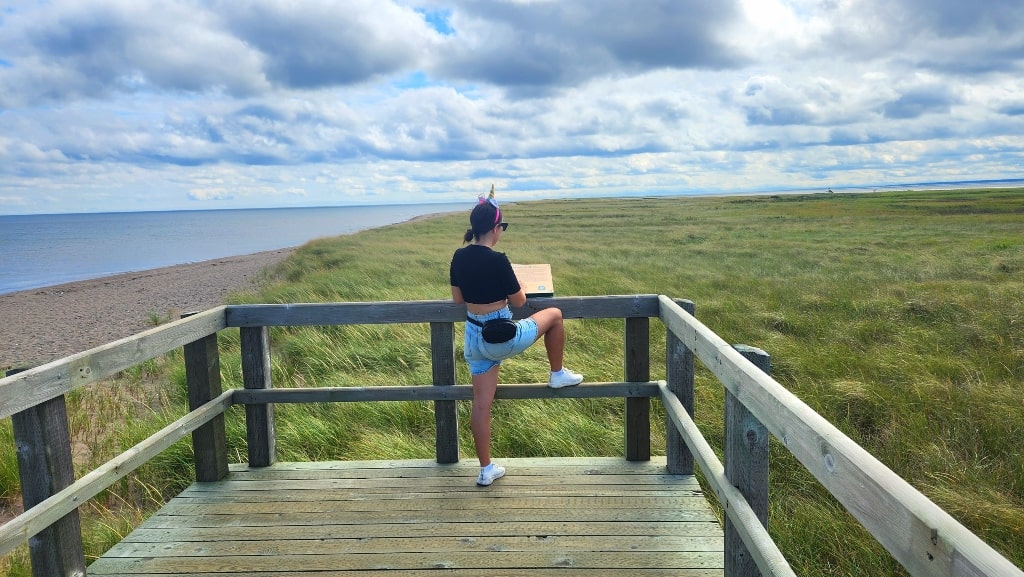
🦄 If you are looking for more helpful content about the Maritimes, check out these blog posts:
Is Fredericton A Walkable City? Guide To Getting Around The City
Is There Uber In Halifax
How Often Does It Snow In Nova Scotia?
10 Fun Things To Do In Halifax For Adults
What Are People From Halifax Called?
This Coastal Town Near Halifax Is A Must Visit
Is Halifax A Walkable City? + Most Walkable Neighborhood
Meridian63° Luxury Camping Review
Is Charlottetown Worth Visiting? Things To Do & Reasons To Visit
15 Best Places To Visit In Canada In December
Conclusion
In conclusion, visiting Hopewell Rocks is a truly unforgettable experience.
Which offers a rare opportunity to witness the power of the world’s highest tides.
Whether you’re walking on the ocean floor at low tide or kayaking around the towering rock formations at high tide, the dynamic landscape provides breathtaking views.
The unique “flowerpot” rocks, stunning coastal scenery, and interactive opportunities like the Interpretive Centre make Hopewell Rocks a must-visit destination for anyone exploring the Canadian Maritimes.
A visit is an unforgettable encounter with one of the world’s most remarkable natural phenomena.
